GRAPHICS OF 1650-PS ("BULLET ORDER") ("GERMAN" DOCUMENT WITH ENGLISH-LANGUAGE STAMPS)
(Note: There are at least 2 different versions of this document, one with English-language stamps, the other without.
Only the version with the stamps was introduced into evidence at Nuremberg.
The stamps were added at Nuremberg.
For the other one available at the moment, click here.
For analysis followed by translation, click here.
"The prisoners of war are to be put in irons on the transport..."
from official IMT "translation".
(They quote these things, but they never let you see what they look like.
The document is a teletype, so how the signature got there is anybody's guess. Since the "document" is more or less illegible, we hope the "translation" was written last.
)
If this document means anything at all, it means that prisoners who attempt to escape are to be isolated and chained to a "Kugel" (iron ball), not shot with a "Kugel" (bullet). Be that as it may, what the hell are the English-language ("CONFIDENTIAL") stamps doing on every page of the document? Did the Germans run out of their own stamps and start using English ones, or did the Americans find the document and stamp it with their own stamps, thus tampering with the evidence? What would they do that for? Which is crazier? The stamps appear to be an integral part of the document. No one mentioned this obvious fact at any time during the Nuremberg Trial. It's like the steam chambers: one gets the impression that the defence and defendants were reluctant to embarrass the prosecution by pointing out very obvious facts.
My personal belief is that the stamp was added by a Russian who didn't know one European language from another, but who had a collection of stamps and knew that the stamp meant "confidential" in Russian.
It might be considered inherently improbable that anyone (almost certainly the Soviets) would be stupid enough to forge a complex German document and then put English-language stamps all over it, as in the case of Document 1650-PS (the so-called "Bullet Order"); and that therefore this document must, for some strange reason, be authentic.
The simple fact, however, is that forgers make stupid mistakes like this all the time. Examples of their stupidity (and occasional genius) may be found all over the Internet. Techniques of forgery have evolved exponentially since 1945; but forgers, as people, are still making the same mistakes they made 55 years ago at Nuremberg. The difference is that, today, nobody gets hanged.
[fakeID1]

Above: "Novelty" "International Youth Card" has an English word in the middle of the French text, exactly like Document 1650-PS (i.e., "EUROPEAN" instead of "EUROPEENNE"); (correct: "CARTE JEUNE EUROPEENNE"). The French accent marks are simply missing (Nationalité, Né(e) le:). Compare the total lack of sharp-S (ß) and/or incorrect German punctuation in Document L-3 and L-180 (graphics).
[fakeID2] [thumbnail only]
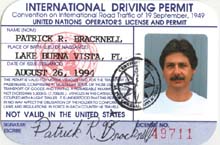
Above: This "novelty""International Driving License" has a Spanish word in the middle of a French text, exactly like Document 1650-PS ("Signature/Escribe", lower left-hand corner ) – they think that's French!
(Note for the Hispanically challenged: "Escribe" means "he/she writes", or "Write!")
[fakeID3] [enlarged thumbnail]
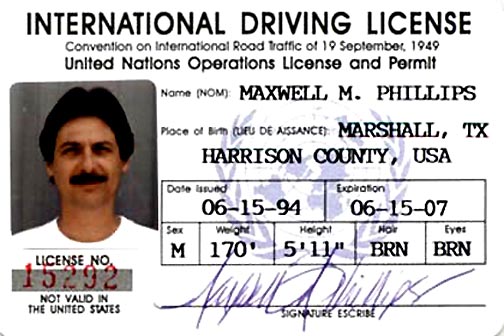
Above: This "novelty" International Driver's License" has "Place of Birth" misspelled in French ("Lieu de Aissance" instead of "Lieu de Naissance"), and also says "Signature/Escribe". Another Nuremberg-style botch-up.
[fakeID4] [thumbnail only]

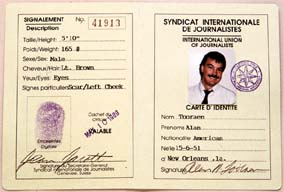
Above: This backdated, "novelty" "International Union of Journalists" card has simply deleted all the French accent marks ("Prénom", "Né le") or replaced them with apostrophes. "Syndicat Internationale" should be "Syndicat International", without "e". The only thing missing here is a Soviet "Certified True Copy" stamp and a statement in Russian signed by a Commissar.
[fakeID5]
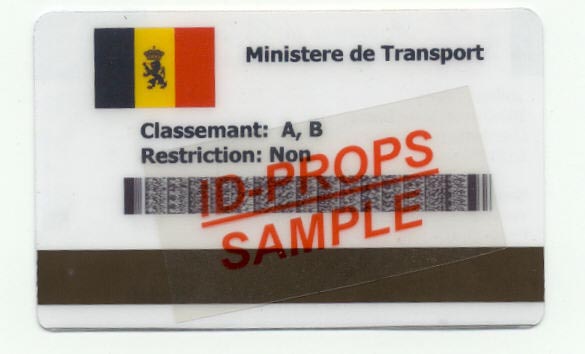
Above: This "novelty" "Belgian Driving Permit" states "Ministere de Transport" instead of "Ministère des Transports"[with grave accent over the "e"]. "Classemant" should be "Classement". "Restriction: Non" should be "Restrictions: Néant". (Another card produced by the same person has "Classement" spelled correctly.)
[fakeID6]
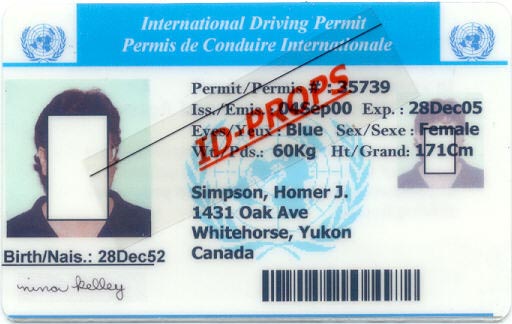
Above: This "novelty" "International Driving Permit" calls itself a "Permis de Conduire Internationale" instead of "Permis de Conduire International" (without "e"): "Grand" should be "Taille", and "Nais.:" should be "Né(e) le:"
[fakeID7]
[lost]
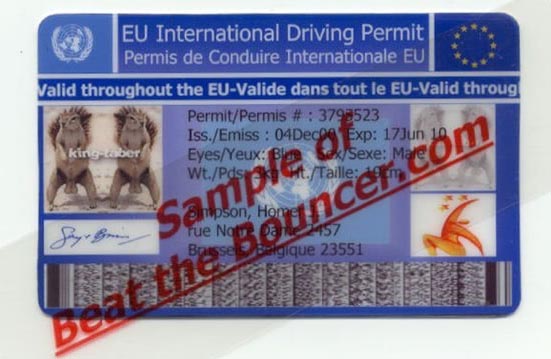
Above: This "novelty" "EU International Driving Permit" calls itself a "Permis de Conduire Internationale EU" instead of "Permis de Conduire International UE". "Valide dans tout l'EU" should be "Valable dans toute l'UE" or, much better, "Valable dans tous les pays de l'UE". "Emiss" should be "Emis". "Brussels/Belgique" should be either "Bruxelles/Belgique" or "Brussels/Belgium". 2 is the postal code for Antwerp.
There are only 4 digits in Belgian postal codes.
[The squirrels appear to be some sort of Canadian in-joke, possibly implying that anybody who buys a forgery like this is a bit stupid.]
[fakeID8]
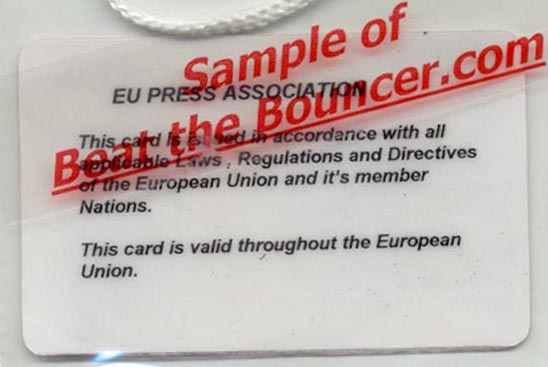
Above: This card speaks of "the European Union and it's member Nations" (instead of "its Member States", which is not only correct English but basic EEC jargon). Astonishingly, cards 5, 6, 7, and 8 are produced by a French-Canadian resident of Montreal, Robert Gygi. Monsieur Gygi appears to be technically quite a genius, but is perhaps not so bright verbally.
[Fake ID9]
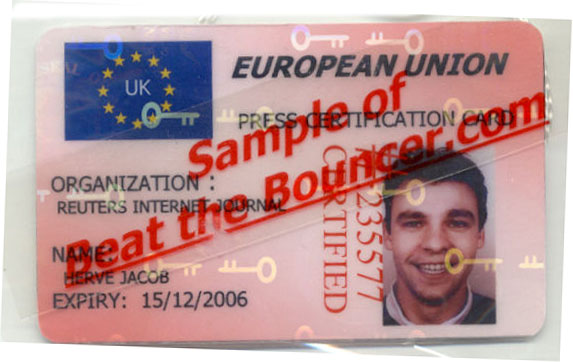
Above: "Organisation" is not spelled with a "z" in the so-called "European Union", etc. etc.
"Organization" is considered "American" and strictly non-kosher.
It looks trivial and it is, but I guarantee you would never get away with it.
They throw fits all the time just over silly stuff like this!
Forgeries are often revealed by trivialities.
"F" for "Failure".
[Fake ID10]

Above: In this case, the Sardinian province of "Cagliari" (pronounced CAL-ya-ry) is misspelled "Cagalari", guaranteed to make any Romance-language speaker laugh (since it suggests the verb "to shit" [cacare, cagar, faire caca] in probably all Latin-based languages and dialects).
[Fake ID11]
[lost]
Above: Another "novelty" driver's licence in incorrect French ('Secutiré publique' instead of 'Securité publique'); compare "Einzigste Ausfertigung" in the so-called "Just Vermerk" (Nurembeg "documentary proof" of the existence of "gas vans").
---
The point being that even highly expert forgers do not necessarily know one language from another, and that the idea of a Soviet forger putting English-language stamps on a German document is not at all far-fetched.
---
What is most astonishing is that "evidence" which would be rejected in the case of a teenager trying to buy beer or get into a night club is considered perfectly good enough to defame an entire nation (the Germans) and all of Western civilization (for its "complicity in the Holocaust"), generating trillions of dollars in reparations, rip-offs, extortion rackets, and special privileges for Israel, Jews, homosexuals, blacks, and "minorities" generally, in a state of media-induced mass psychosis (for example, "Safe Rooms" marked by inverted purple triangles in tax-supported public schools, where homo, bi, and "trans-gendered persons" may "discuss their sexuality", while "Straight Pride" sweatshirts are banned as "offensive", and all display of Christian symbols is prohibited.
CARLOS W. PORTER
APRIL 8, 2001
(Note: In changing from upper to lower case in the above, I have capitalized the entries as one would in English. The French don't capitalize the way we do in English.)
--
The standard version of events is that the Allies examined 100,000 documents and chose 1,000 which were introduced into evidence, and that the original documents were then deposited in the Peace Palace at The Hague. This is rather inexact.
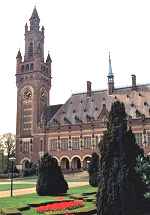
The documents used in evidence at Nuremberg consisted largely of "photocopies" of "copies". Many of these original documents were written entirely on plain paper without handwritten markings of any kind, by unknown persons. Occasionally, there is an illegible initial or signature of a more or less unknown person certifying the document as a 'true copy'. Sometimes there are German stamps, sometimes not. Many have been 'found' by the Russians, or 'certified authentic' by Soviet War Crimes Commissions.
Volume XXXIII, a document volume taken at random, contains 20 interrogations or affidavits, 12 photocopies, 5 unsigned copies, 5 original documents with signatures, 4 copies of printed material, 3 mimeographed copies, 3 teletypes, 1 microfilm copy, 1 copy signed by somebody else and 1 unspecified.
The Hague has few, if any, original documents. The Hague has many original postwar 'affidavits', or sworn statements, the Tribunal Commission transcripts, and much valuable defense material. They have the 'human soap', which has never been tested, and the 'original human soap recipe' (Document USSR-196), which is a forgery; but apparently no original wartime German documents.
The Hague has negative photostats of these documents, on extremely brittle paper which has been stapled. To photocopy the photostats, the staples are removed. When they are re-stapled more holes are made. Most of these documents have not been photocopied very often, and officials at The Hague say it is very unusual for anyone to ask to see them.
The National Archives in Washington (see Telford Taylor's Use of Captured German and Related Documents, A National Archive Conference) claim that the original documents are in The Hague. The Hague claims the original documents are in the National Archives.
The Stadtsarchiv Nurnberg and the Bundesarchiv Koblenz also have no original documents, and both say the original documents are in Washington. Since the originals are, in most cases, 'copies', there is often no proof that the documents in question ever existed.
Robert Jackson got the trial off to a start by quoting the following forged or otherwise worthless documents (II 120-142): 1947-PS; 1721-PS; 1014-PS; 81-PS; 212-PS ; and many others.
1947-PS is a 'copy' of a 'translation' of a letter from General Fritsch to the Baroness von Schutzbar-Milchling. The Baroness later signed an affidavit stating that she never received the letter in question (XXI-381).
The falsified 'letter' from General Fritsch to the Baroness von Schutzbar-Milchling was recognized as such during the trial and is not included in the document volumes, where it should appear at XXVIII 44. Jackson was not, however, admonished by the Tribunal. (XXI 380)
The enthusiastic Americans apparently forged 15 of these 'translations', after which the original documents all disappeared (See Taylor, Captured Documents).
1721-PS is a forgery in which an SA man writes a report to himself about how he is carrying out an order which is quoted verbatim in the report. Handwritten markings on page 1 (XXI-137-141; 195-198; 425; XXII 148-150. See also Testimony Before the Commission, Fuss, 25 April, and Lucke, 7 May 1946). The National Archives have a positive photostat of 1721-PS, and The Hague has a negative photostat. The 'original' is a photocopy (XXVII 485).
1014-PS is a falsified 'Hitler Speech' written on plain paper by an unknown person. The document bears the heading 'Second Speech' although it is known that Hitler gave only one speech on that date. There are four versions of this speech, 3 of them forgeries: 1014-PS, 798-PS, L-3 , and an authentic version, Ra-27 (XVII-406-408; XVIII 390-402; XXII 65). The third forgery, Document L-3, bears an FBI laboratory stamp and was never even accepted into evidence (II 286), but 250 copies of it were given to the press as authentic (II 286).
This document is quoted by A.J.P. Taylor on page 254 of The Origins of the Second World War (Fawcett Paperbacks, 2nd Edition, with Answer to his Critics) giving his source as German Foreign Policy, Series D vii, No 192 and 193.
L-3 is the source of many statements attributed to Hitler, particularly "who today remembers the fate of the Armenians?" and "our enemies are little worms, I saw them at Munich". 'Hitler' also compares himself to Genghis Khan and says he will exterminate the Poles, and kick Chamberlain in the groin in front of the photographers. The document appears to have been prepared on the same typewriter as many other Nuremberg documents, including the two other versions of the same speech. This typewriter was probably a Martin from the Triumph-Adler-Werke, Nuremberg.
81-PS is a 'certified true copy' of an unsigned letter on plain paper prepared by an unknown person. If authentic, it is the first draft of a letter never sent. This is invariably spoken of as a letter written by Rosenberg, which Rosenberg denied (XI 510-511). The document lacks signature, initial, blank journal number (a bureaucratic marking) and was not found among the papers of the person to whom it was addressed. (XVII 612).
81-PS is a 'photocopy' with a Soviet exhibit number (USSR-353, XXV 156-161).
212-PS was also prepared by an unknown person, entirely on plain paper, without any handwritten markings, date, address, or stamp (III 540, XXV 302-306; see also photocopies of negative photostats from The Hague).
This is, unfortunately, only typical. Document 386-PS, the 'Hossbach Protokoll', Hitler's supposed speech of 5 November 1938, is a certified photocopy of a microfilm copy of a re-typed 'certified true copy' prepared by an American, of a re-typed 'certified true copy' prepared by a German, of unauthenticated handwritten notes by Hossbach, of a speech by Hitler, written from memory 5 days later. This is not the worst document, but one of the best, because we know who made one of the copies. The text of 386-PS has been 'edited' (XLII 228-230).
Thus 'trial by document' works as follows: A, an unknown person, listens to alleged 'oral statements' made by B, and takes notes or prepares a document on the basis of those alleged oral statements. The document is then introduced into evidence, not against A, who made the copy, but against B, C, D, E and a host of other people, although there is nothing to connect them with the document or the alleged statements. It is casually stated as fact that 'B said', or that 'C did', or that 'D and E knew'. This is contrary to the rules of evidence of all civilised countries. Nor are the documents identified by witnesses.
The forgery of original documents was rarely resorted to at Nuremberg, because the documents were not brought to court. The "original document" - that is, the original unsigned "copy" - was kept in a safe in the Document Centre (II 195, 256-258).
Then, 2 "photocopies" of the "copy" (V 21) or 6 photocopies (II 251-253) were prepared and brought to court. All other copies were re-typed on a mimeograph using a stencil (IX 504).
In the transcript, the word "original" is used to mean "photocopy" (II 249-250, XIII 200, 508, 519; XV 43, 169, 171, 327) to distinguish the photocopies from the mimeograph copies (IV 245-246).
"Translations" of all documents were available from the beginning of the trial (II 158-161, 191, 195, 215, 249-250, 277, 415, 437) but the "original" German texts were not available until at least two months later. This applies not just to the trial briefs and indictment, etc. but to ALL DOCUMENTS . The defense received no documents in German until after January 9, 1946 (V 22-26).
Documents which appear to have been prepared on the same typewriter include Document 3803-PS , a letter from Kaltenbrunner to the Mayor of Vienna, and the cover letter from this same Mayor sending Kaltenbrunner's letter to the Tribunal (XI 345-348). This letter from Kaltenbrunner contains a false geographical term (XIV 416).
See also NOT GUILTY AT NUREMBERG
In English
In German
Return to ARTICLES PAGE
Return to CONTENTS PAGE